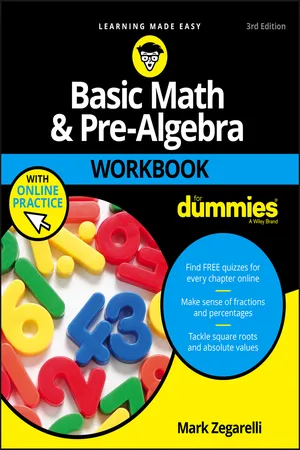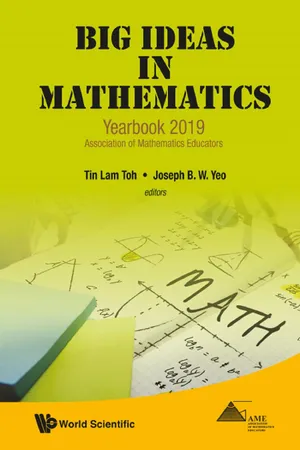Mathematics
Factorising expressions
Factorising expressions involves breaking down an algebraic expression into a product of its factors. This process helps to simplify and solve equations, as well as identify common factors within an expression. By factoring, one can often find solutions to equations and gain a deeper understanding of the relationships between different terms in the expression.
Written by Perlego with AI-assistance
Related key terms
Related key terms
1 of 4
Related key terms
1 of 3
7 Key excerpts on "Factorising expressions"
- eBook - ePub
- Toby Wagner(Author)
- 2021(Publication Date)
- Chemeketa Press(Publisher)
CHAPTER 5Factoring
When multiplying, the result is known as a product, and the numbers being multiplied are known as factors. In the equation 3 – 2 = 6, for example, the product is 6, and the factors are 3 and 2.Factoringis the process of breaking a number or algebraic expression down into its factors. In previous math courses, you may have used this process to create prime factorizations. For example, the prime factorization of 24 is 2 · 2 · 2 · 3. In this chapter, we will be factoring polynomials.Our primary focus will be on second-degree polynomials, but we will also encounter higher-degree expressions. After learning the various methods and techniques that can be used when factoring polynomials, we’ll use factoring to help us simplify rational expressions.This chapter is composed of the following sections:5.2 Factoring Trinomials of the Form x2 + bx + c5.1 Factoring out the Greatest Common Factor5.3 Special Cases for Factoring5.4 Simplifying Rational Expressions5.1 Factoring Out the Greatest Common Factor
Overview
At this point, you should be comfortable with operations — addition, subtraction, multiplication, division, and exponents — and how they pertain to polynomials. Now it’s time to learn how to reverse the multiplication process. Here’s a problem that does this:Factor out the GCF: 9x3 + 18x2 + 27xGCF stands for Greatest Common Factor, but what does the GCF look like when variables are involved? And how does one go about factoring out a GCF? We need answers for these questions before we are ready to tackle this problem.This section will introduce you to factoring and teach you how to: ◆ Determine the other factor when given a polynomial and one monomial factor ◆ Identify and factor out the greatest common factor (GCF) ◆ Use grouping to factor polynomialsA. Finding a Missing Factor
In Chapter 4 - Mark Zegarelli(Author)
- 2017(Publication Date)
- For Dummies(Publisher)
Part 4 The X Factor: Introducing Algebra IN THIS PART… Evaluate algebraic expressions by plugging in numbers for variables. Simplify expressions by removing parentheses and combining like terms. Factor expressions using the greatest common factor of all the terms. Solve algebraic equations by isolating the variable. Use cross-multiplication to solve equations with fractions. Chapter 14 Expressing Yourself with Algebraic Expressions IN THIS CHAPTER Evaluating algebraic expressions Breaking an expression into terms and identifying like terms Applying the Big Four operations to algebraic terms Simplifying and FOILing expressions In arithmetic, sometimes a box, a blank space, or a question mark stands for an unknown number, as in,, or. But in algebra, a letter such as x stands for an unknown number. A letter in algebra is called a variable because its value can vary from one problem to the next. For instance, in the equation, x has a value of 2 because. But in the equation, x has a value of 6 because. Here are a few algebra conventions you should know: Multiplication: When multiplying by a variable, you rarely use the multiplication operator. As in arithmetic, you can use parentheses without an operator to express multiplication. For example, 3(x) means. Often, the multiplication operator is dropped altogether. For example, 3 x means Division: The fraction bar replaces the division sign, so to express, you write. Powers: Algebra commonly uses exponents to show a variable multiplied by itself. So to express, you write x 2 rather than xx. To express xxx, you write x 3. An exponent applies only to the variable that it follows, so in the expression 2 xy 2, only the y is squared. To make the exponent apply to both variables, you’d have to group them in parentheses, as in 2(xy) 2. In this chapter, you find out how to read, evaluate, break down, and simplify basic algebraic expressions- eBook - ePub
- Mary Jane Sterling(Author)
- 2016(Publication Date)
- For Dummies(Publisher)
Part 2Figuring Out Factoring
IN THIS PART …Here you find out how to rearrange algebraic expressions to make them more usable. Factoring is always a high priority in mathematics, and I cover it in depth in this part. You use factoring when solving equations and to compare expressions. Polynomials in factored form are more useful when you’re graphing. The techniques found in these chapters help you recognize what type of factoring to perform and how to do it.Passage contains an image Chapter 6
Working with Numbers in Their Prime
IN THIS CHAPTER Preparing for perplexing prime numbers Bringing big numbers down to size: Divisibility rules! Investigating composite numbers with prime factorizations Finding and using factoring methodsPrime numbers (whole numbers evenly divisible only by themselves and one) have been the subject of discussions between mathematicians and non-mathematicians for centuries. Prime numbers and their mysteries have intrigued philosophers, engineers, and astronomers. These folks and others have discovered plenty of information about prime numbers, but many unproven conjectures remain. Prime numbers play an important role in coding (encrypting passwords and protecting information).Probably the biggest mystery is determining what prime number will be discovered next. Computers have aided the search for a comprehensive list of prime numbers, but because numbers go on forever without end, and because no one has yet found a pattern or method for listing prime numbers, the question involving the next big one remains.Beginning with the Basics
Prime numbers are important in algebra because they help you work with the smallest-possible numbers. Big numbers are often unwieldy and can produce more computation errors when you perform operations and solve equations. So, reducing fractions to their lowest terms and factoring expressions to make problems more manageable are basic and very desirable tasks. - eBook - ePub
- Mary Jane Sterling(Author)
- 2017(Publication Date)
- For Dummies(Publisher)
For instance, in the first example in this section, the denominator, 6 y, divides every term in the numerator. To emphasize the common factor business, I first factor the numerator by dividing out the 6 y, and then I reduce the fraction. As nice as it would be if algebraic expressions always divided evenly, that isn’t always the case. Often, you have one or more terms in the expression — in the fraction’s numerator — that don’t contain all the factors in the divisor (denominator). When this happens, the best strategy is to break up the problem into as many fractions as there are terms in the numerator. In the end, though, the method you use is pretty much dictated by what you want to do with the expression when you’re done. Q. A. The numerator contains a factor matching the denominator. Q. A. The last term doesn’t have a factor of 4 x, so you break up the numerator into separate fractions for the division. 1 2 3 4 Dividing by a Binomial Dividing by a binomial (two terms) in algebra means that those two terms, as a unit or grouping, have to divide into another expression. After dividing, if you find that the division doesn’t have a remainder, then you know that the divisor was actually a factor of the original expression. When dividing a binomial into another expression, you always work toward getting rid of the lead term (the first term — the one with the highest power) in the original polynomial and then the new terms in the division process. See the following example for a clearer picture of this concept. This example shows a dividend that starts with a third-degree term and is followed by terms in decreasing powers (second degree, first degree, and zero degree, which is a constant — just a number with no variable) - eBook - ePub
Computer Algebra
Concepts and Techniques
- Edmund A. Lamagna(Author)
- 2019(Publication Date)
- CRC Press(Publisher)
Chapter 6 Factorization It has often been said that a person does not really understand something until he can teach it to someone else. Actually a person does not really understand something until he can teach it to a computer. Donald E. Knuth “Computer Science and Its Relation to Mathematics,” American Mathematical Monthly, 81 (1974) As soon as an Analytical Engine exists, it will necessarily guide the future course of the science. Whenever any result is sought by its aid, the question will then arise—By what course of calculation can these results be arrived at by the machine in the shortest time. Charles Babbage (1791–1871) Passages from the Life of a Philosopher, 1864 The methods we learned in algebra to factor polynomials rely on a certain amount of pattern matching, guesswork, and just plain luck. They work well for quadratics, a few special cubics, and perhaps an occasional polynomial of higher degree where one or two roots are obvious. One of the more impressive capabilities of computer algebra systems is their ability to factor polynomials reliably and efficiently. How do these systems solve this problem? 6.1 What is Factoring? We begin by addressing the question of what it means to factor a polynomial. Let’s examine the response of a typical computer algebra system, Maple, to a few simple factorization. problems. factor (x ^ 2 − 9) → (x − 3) (x + 3) (6.1) factor (4 x ^ 2 + 16 * x + 16) → 4 (x + 2) 2 (6.2) factor (x ^ 2 − 9 / 16) → 1 16 (4 x − 3) (4 x + 3) (6.3) factor (x ^ 2 − 7) → x 2 −[--=PLGO-SEPARA. TOR=--]7 (6.4) factor (x ^ 2 + 9) → x 2 + 9 (6.5) The first two answers are not surprising. By analogy with (6.1), we might expect (x − 3 4) (x + 3 4) to be returned for (6.3). The polynomials in (6.4) and (6.5) are returned unfactored. Why not answer (x − 7) (x + 7) and (x − 3 i) (x + 3 i), respectively? When factoring polynomials, we need to do so with respect to some algebraic system - eBook - ePub
Big Ideas in Mathematics
Yearbook 2019, Association of Mathematics Educators
- Tin Lam Toh, Joseph B W Yeo(Authors)
- 2019(Publication Date)
- WSPC(Publisher)
for (iv) and for (v) are resources we draw upon from previously-taught topics in earlier years]. We may now place the big ideas of these adjacent topics together for easier comparison:•For “simplification …” topic: we factorise to look for common factors in both the numerator and the denominator. •For “multiplication and division …” topic: form products of fractions, then factorise to look for common factors in both the numerator and the denominator.Clearly, the common big idea across these topics is “factorise to look for common factors in numerator and denominator”. Pushing on, we consider further another neigbouring topic on “addition and subtraction of algebraic fractions”. Using the same method, we highlight this prototypical example in this topic:(vi)Again, we see here that factorisation is a key step in the process of combining the given fractions. Here, although the goal of factorisation differs from the earlier topics – while the previous topics look for common factors in the numerator and the denominator, for addition and subtraction, the focus is on looking for common factors in the numerator – there is nevertheless a common overarching idea behind the techniques employed in all these topics: “We factorise to enable us to see better …”, as illustrated in a different representation of (vi) above:The above step presents more clearly the factors needed in the denominators to achieve “same denominator” in order to form a single fraction. [Again, it is acknowledged that there are other skills involved to complete the solution. The focus of our inquiry is on ideas that are central and are in common across neighbouring topics, not on the detailed analyses of each item].Taking stock of our inquiry so far, we see that when we start with exercise items within a topic, upon careful study of their common mathematical basis, we can extract some ‘small ideas’. In particular, from the topic on “simplifying algebraic fractions’, we note that “we factorise to help us see the common factors in the numerator and the denominator”. We then zoom-out from the topic to its neighbouring topics to consider if this big idea within a smaller domain can be somewhat generalized to a wider region of topics. As it turns out, while the setting in each topic is different – no more restricted to the purpose of looking for common factors in the numerator and denominator – the ‘core’ and more general idea remains: “We factorise to enable us to see better …”. This more generalised statement that is adjusted for relevance for a wider range of neighboring topics can then be taken – for our purpose – as one big idea for these topics. - eBook - ePub
- Mark Zegarelli(Author)
- 2016(Publication Date)
- For Dummies(Publisher)
Begin by turning the problem into a fraction: Cancel out factors in coefficients that are in both the numerator and the denominator. In this case, you can cancel out a 3. Notice that when the coefficient in xy becomes 1, you can drop it: Cancel out any variable that’s in both the numerator and the denominator. You can break x 2 out as xx: Now you can clearly cancel an x in both the numerator and the denominator: As you can see, the resulting fraction is really a reduced form of the original. As another example, suppose you want to divide –6 x 2 yz 3 by –8 x 2 y 2 z. Begin by writing the division as a fraction: First, reduce the coefficients. Notice that, because both coefficients were originally negative, you can cancel out both minus signs as well: Now you can begin canceling variables. I do this in two steps, as before: At this point, just cross out any occurrence of a variable that appears in both the numerator and the denominator: You can’t cancel out variables or coefficients if either the numerator or the denominator has more than one term in it. This is a very common mistake in algebra, so don’t let it happen to you! Simplifying Algebraic Expressions As algebraic expressions grow more complex, simplifying them can make them easier to work with. Simplifying an expression means (quite simply!) making it smaller and easier to manage. You see how important simplifying expressions becomes when you begin solving algebraic equations. For now, think of this section as a kind of algebra toolkit. Here I show you how to use these tools. In Chapter 22, I show you when to use them. Combining like terms When two algebraic terms contain like terms (when their variables match), you can add or subtract them (see the earlier section “Considering algebraic terms and the Big Four”). This feature comes in handy when you’re trying to simplify an expression. For example, suppose you’re working with the following expression: As it stands, this expression has six terms
Index pages curate the most relevant extracts from our library of academic textbooks. They’ve been created using an in-house natural language model (NLM), each adding context and meaning to key research topics.
Explore more topic indexes
Explore more topic indexes
1 of 6
Explore more topic indexes
1 of 4






